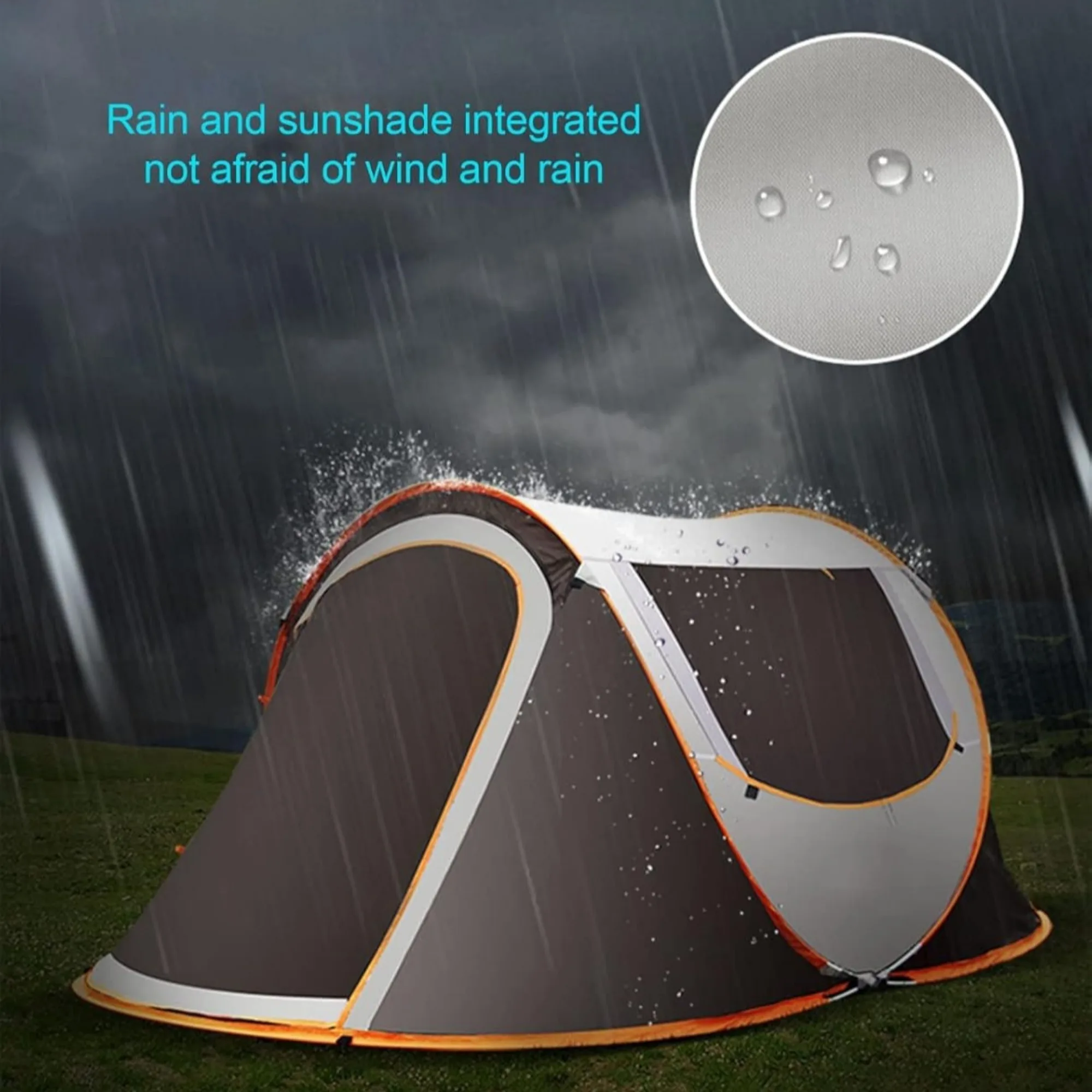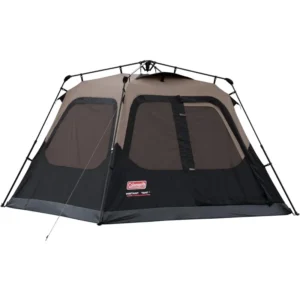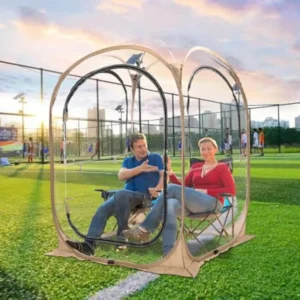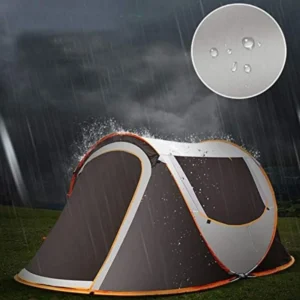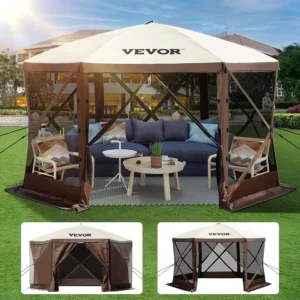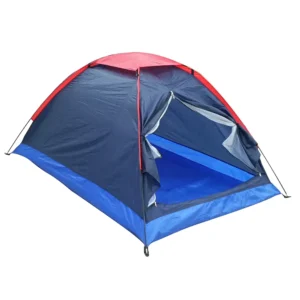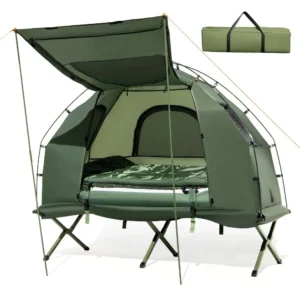What Makes a Tent “Quick Assembly”? Understanding the Basics
When it comes to camping, setting up your shelter can either be a relaxing start to your outdoor adventure or a frustrating ordeal that dampens your spirits. Quick assembly tents have revolutionized the camping experience by dramatically reducing setup time from the traditional 15-30 minutes to mere minutes or even seconds.
These innovative shelters use clever design elements to streamline the setup process:
- Pre-attached poles that eliminate the need to thread poles through sleeves
- Spring-loaded frames that pop into position when released
- Integrated hub systems where poles extend and lock with minimal effort
- Inflatable beam technology that replaces traditional rigid poles
You might see these tents marketed under various names including instant tents, pop-up tents, or fast-pitch tents. While the terminology varies, they all share the same core benefit: getting you protected from the elements with minimal time and effort.
Quick assembly tents are particularly popular among specific groups of campers:
– Beginners who might feel intimidated by complex tent setups
– Families with young children who need shelter established quickly
– Festival-goers who prioritize convenience
– Weekend campers who want to maximize relaxation time
The evolution of tent design has come a long way from the days when setting up camp meant methodically assembling poles, threading them through fabric sleeves, and carefully raising your shelter piece by piece. Modern quick-setup tent options offer remarkable convenience without sacrificing protection.
Understanding what defines a quick-pitch tent helps set appropriate expectations about what these innovative shelters can and cannot do. With setup times ranging from as little as 30 seconds to about 5 minutes, they represent a significant advancement in camping convenience.
The Major Benefits of Quick Assembly Tents
The appeal of quick assembly tents extends far beyond just saving a few minutes. These innovative shelters transform the camping experience in several meaningful ways:
Time Efficiency
• Set up camp in seconds to minutes rather than the 15-30 minutes required for traditional tents
• Reallocate that saved time to activities you actually enjoy, like hiking, fishing, or simply relaxing
Ease of Use
• Eliminate the frustration of deciphering complex instructions and sorting through numerous poles
• Reduce the learning curve for newcomers to camping who might be intimidated by traditional setups
• Minimize the physical demands of tent setup, making camping more accessible for all ages
Weather Protection When You Need It
• Quickly establish shelter when unexpected rain arrives
• Create immediate protection as daylight fades or temperatures drop
• Avoid exposure to elements during lengthy setup procedures
Stress Reduction
• Remove a common source of camping frustration and potential for arguments
• Start your outdoor experience with a positive accomplishment rather than a challenging task
Independence in Camp Setup
• Complete the process alone without requiring help from others
• Empower solo campers to establish their shelter without assistance
• Allow one person to set up while others handle different camp tasks
The comprehensive benefits of pop-up camping tents extend to campers of all experience levels. For families, the ability to quickly establish shelter can be particularly valuable when camping with overtired children or when arriving at a campsite later than planned.
The transformative convenience and various essential features of quick-setup tents have made them increasingly popular for casual and occasional campers who prioritize simplicity and efficiency in their outdoor adventures.
Potential Limitations to Consider
While quick assembly tents offer impressive convenience, it’s important to understand their trade-offs to make an informed decision about whether they’re right for your camping style:
Size and Portability Challenges
Quick assembly tents typically pack down into larger, more awkward shapes compared to traditional tents of similar size. The integrated pole systems and pre-attached components that make setup fast also create bulkier packed dimensions. This makes them less ideal for backpacking or situations where space is at a premium in your vehicle.
Weather Performance Considerations
Some quick assembly models—particularly basic pop-up tents—may offer reduced stability in challenging weather conditions. Their simplified designs can sometimes mean:
- Less rigid frames in high winds
- Fewer anchor points for guylines
- Simplified rainfly coverage in heavy precipitation
However, it’s worth noting that higher-end quick assembly options have significantly improved their weather resistance for fast-pitch tents, closing this gap with traditional designs.
Durability and Repair Challenges
The integrated nature of quick assembly tent systems creates potential long-term considerations:
- If one component breaks, repairs may be more complex
- Field repairs can be more challenging without separate components
- Replacement parts may be more specialized
Price Premium
The convenience of quick assembly typically comes with a higher price tag compared to traditional tents of similar size and quality. You’re paying for the engineering and design that makes that quick setup possible.
Design Compromises
To achieve their rapid setup, some quick assembly tents make sacrifices in other areas:
– Less customizable ventilation
– Sometimes reduced headroom or less efficient use of interior space
– Fewer options for vestibules or additional covered space
These limitations don’t necessarily make quick assembly tents inferior—they simply represent different design priorities. Understanding these trade-offs helps you determine whether the tremendous convenience of rapid setup outweighs these considerations for your specific camping needs.
Types of Quick Assembly Tents: Which Is Right for You?
The quick assembly tent category includes several distinct designs, each with its own unique advantages and best-use scenarios. Understanding these differences will help you select the perfect option for your specific camping needs.
Pop-Up Tents (Spring-Loaded Design)
These tents use coiled, flexible frames that spring into shape automatically when released from their carrying bag. Simply unpack, untwist any securing straps, and the tent practically sets itself up.
Advantages:
– Lightest of the quick assembly options
– Setup time of 5-20 seconds (practically instant)
– Often the most budget-friendly quick assembly option
– Extremely beginner-friendly with virtually no learning curve
Limitations:
– Typically smaller in size (1-3 person capacity)
– Less weather-resistant than other options
– More challenging to fold and pack away
– Usually less durable over the long term
Ideal Uses: Festival camping, beach days, backyard sleepovers, fair-weather weekend trips
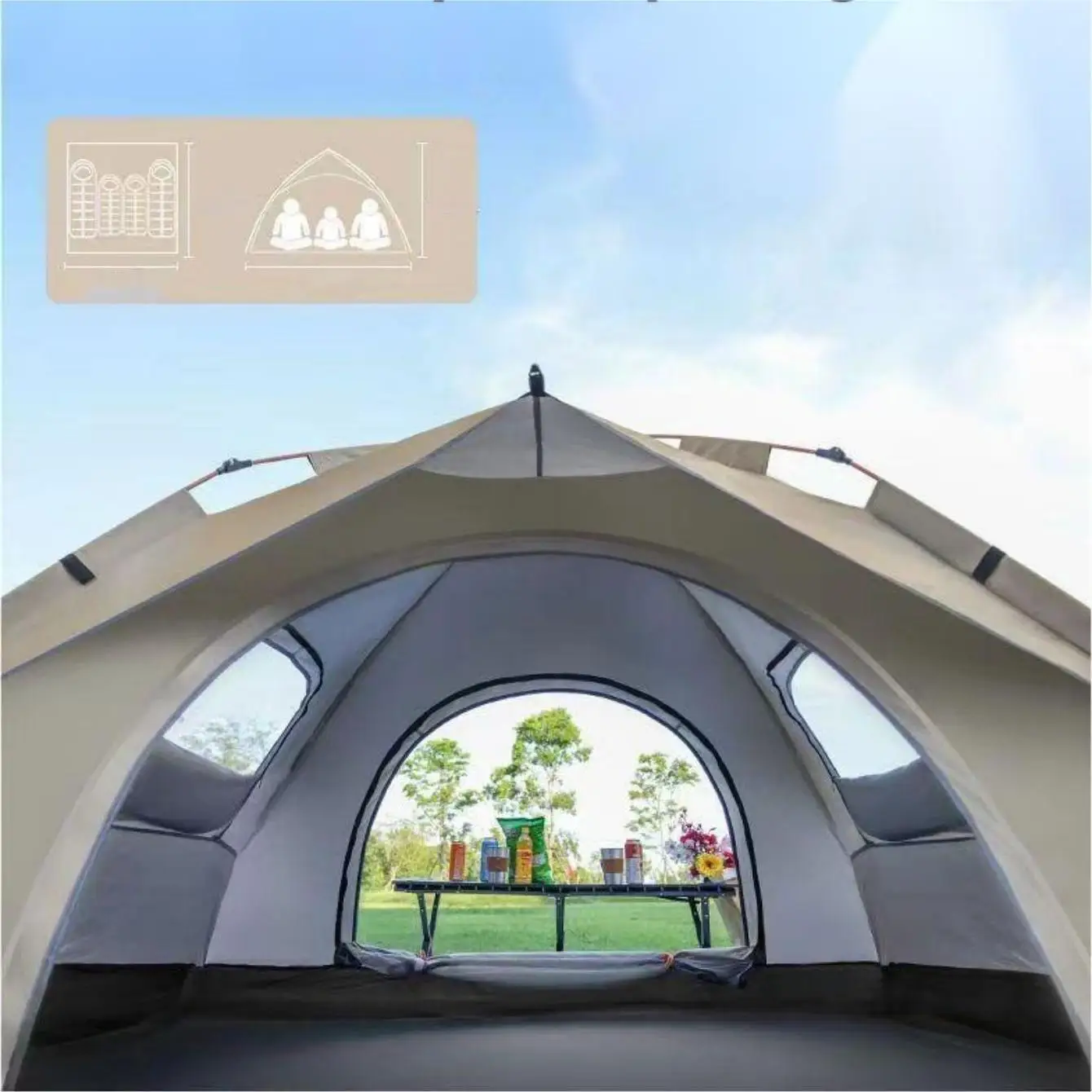
Instant Tents (Pre-Attached Telescoping Poles)
These designs feature pre-attached poles that extend and lock into position, transforming from a compact bundle to a fully structured tent in minutes. The ultimate guide to fast-setup tents shows how these models have become increasingly popular for family camping.
Advantages:
– Excellent balance of setup speed (1-2 minutes) and stability
– Available in larger family sizes (up to 12+ person capacity)
– Better weather resistance than basic pop-ups
– More feature-rich with room dividers, multiple doors, and storage options
Limitations:
– Heavier and bulkier when packed
– More complex mechanisms that can potentially fail
– Higher price point than traditional tents of similar size
Ideal Uses: Family car camping, extended campsite stays, camping in variable weather conditions
Our collection of instant camping tents showcases the range of sizes and features available in this versatile category.
Inflatable Tents (Air Beam Technology)
These innovative designs replace traditional poles with inflatable air beams that provide structure when pumped up. Simply roll out the tent, inflate the beams with the included pump, and secure with stakes.
Advantages:
– Surprising durability and weather resistance
– No breakable poles to worry about
– Excellent stability in windy conditions when properly staked
– Available in large, family-sized options with multiple rooms
Limitations:
– Requires a pump (manual or electric)
– Risk of punctures (though most include repair kits)
– Higher price point than other quick assembly options
– Setup time of 3-7 minutes (quick, but not as fast as other types)
Ideal Uses: Glamping, long-term campsite setups, family camping in changeable weather
Each of these quick assembly tent types offers a different balance of setup speed, stability, features, and price point. Your ideal choice depends on your specific camping style, typical conditions, and personal priorities.
Mastering Setup and Takedown: A Step-by-Step Guide
Even the quickest assembly tent benefits from proper technique during setup and takedown. Following these steps will ensure you get the most from your tent’s convenient design while extending its lifespan.
Pre-Trip Preparation
- Practice at home before your trip to familiarize yourself with the process
- Check that all components are present and functioning properly
- Verify that any inflatable components hold air or that mechanisms operate smoothly
- Review manufacturer’s instructions for any model-specific guidance
General Setup Process
Site Selection:
– Choose level ground free of sharp objects and debris
– Look for natural wind breaks when possible
– Avoid low spots where water might collect
– Consider sun position for shade/warmth as neededInitial Positioning:
– Remove the tent from its storage bag
– Position the folded tent with the door facing your desired direction
– Clear the surrounding area to allow for easy deploymentType-Specific Deployment:
For Pop-Up Tents:
– Carefully release any retention straps or bands
– Allow the tent to spring into its deployed shape
– Make minor adjustments to square the base
For Instant Tents:
– Unfold the tent body completely
– Extend the pre-attached poles until they click into locked position
– Push the center hub up if applicable
For Inflatable Tents:
– Unfold the tent completely
– Connect the pump to inflation valves
– Inflate beams to recommended pressure
- Securing and Weatherproofing:
– Stake down all corners to prevent shifting
– Attach rainfly if not already integrated
– Deploy guylines for additional stability in wind
– Adjust ventilation options based on weather conditions
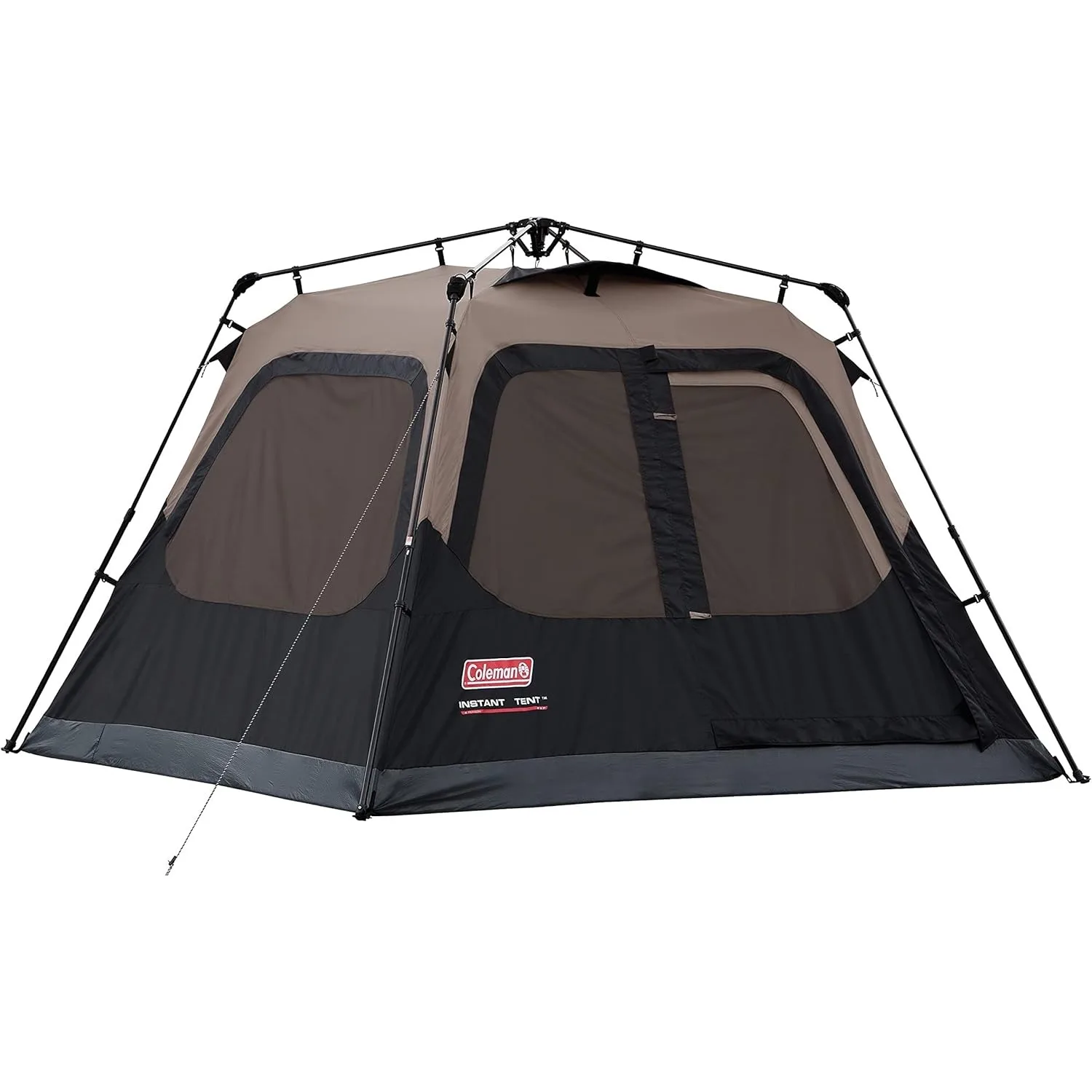
Learning how to pitch an instant tent correctly takes only minutes but makes a significant difference in performance and longevity.
Efficient Takedown Methods
Basic Preparation:
– Remove all personal items from the tent
– Sweep out debris and dirt
– Leave doors and windows unzipped for air escape during foldingType-Specific Takedown:
For Pop-Up Tents:
– Grab opposite edges and fold into a circular shape
– Twist and fold the circle in half
– Secure with built-in straps or bands
For Instant Tents:
– Press release buttons on pole mechanisms
– Collapse poles in the reverse order of setup
– Fold fabric around collapsed frame
For Inflatable Tents:
– Open air valves completely
– Press out air methodically from one end to the other
– Roll tightly toward valve ends to expel remaining air
- Final Packing:
– Ensure the tent is as clean and dry as possible
– Fold to match the dimensions of your storage bag
– Pack additional components like stakes and guylines
– Store in a cool, dry place until next use
Mastering these techniques ensures you’ll enjoy the full convenience benefits of your quick assembly tent while maximizing its lifespan and performance.
Key Buying Considerations: How to Choose the Right Quick Assembly Tent
Selecting the perfect quick assembly tent requires evaluating several important factors beyond just setup time. Here’s what to consider to find the ideal match for your camping needs:
Size and Capacity
- Person ratings: Manufacturer ratings typically assume snug sleeping arrangements. For comfort, consider sizing up (a “4-person” tent comfortably fits 2-3 people with gear).
- Floor dimensions: Check the actual square footage rather than just the person rating.
- Peak height: Determines whether you can stand up inside (typically 6+ feet for comfortable standing).
- Vestibule space: Additional covered area outside the sleeping space for storing dirty/wet gear.
Weather Protection
- Waterproof ratings: Look for hydrostatic head measurements of 1500mm+ for adequate rain protection (3000mm+ for serious weather resistance).
- Rainfly coverage: Full-coverage rainflies offer superior protection compared to partial coverage designs.
- Seam sealing: Factory-sealed seams prevent water infiltration at stitch points.
- Wind stability factors: More guyout points, quality stakes, and lower profiles generally perform better in wind.
Material Quality and Durability
- Fabric denier: Higher numbers indicate thicker, more durable fabric (75D is typical; 150D+ is heavy-duty).
- Pole materials: Fiberglass (budget), aluminum (lightweight/durable), steel (heavy/strong), or air beams (no breakage risk).
- Critical component quality: Examine zippers, stake loops, and guyout reinforcements as these are common failure points.
Weight and Packed Size
- Total packed weight: Ranges from 5-25+ pounds depending on size and features.
- Packed dimensions: Consider your vehicle space and storage limitations.
- Carrying case design: Some include compression straps or backpack-style carrying options.
Ventilation and Comfort
- Mesh panels: More mesh means better airflow but potentially less weather protection.
- Ground vents: Low vents create important cross-ventilation to reduce condensation.
- Single vs. double-wall design: Double-wall tents (separate inner tent and rainfly) generally offer better condensation management.
Our easy-setup camping tent collection features options with varying combinations of these important features to match different camping needs.
Added Features
- Blackout/dark room technology: Blocks sunlight for better sleep and temperature regulation.
- Internal organization: Pockets, gear lofts, and hanging points for convenience.
- Entry/exit design: Multiple doors can reduce disturbance when sharing the tent.
- Electrical access ports: Allow power cords to enter the tent while maintaining weather protection.
Price vs. Value
- Budget options: $40-100 for basic pop-ups with limited weather resistance
- Mid-range: $100-250 for good quality instant tents with better durability
- Premium: $250-500+ for feature-rich, weather-resistant quick assembly options
Our waterproof pop-up tent options demonstrate how premium features can be incorporated into quick-assembly designs without sacrificing protection.
When evaluating these factors, prioritize the elements most important to your typical camping conditions and style. Someone primarily car camping in mild weather will have very different needs than someone facing potential storms or seeking maximum comfort for extended stays.
Best Scenarios for Using Quick Assembly Tents
Quick assembly tents truly shine in specific situations where their unique benefits make a meaningful difference to your outdoor experience:
Family Camping with Young Children
When camping with kids, setting up shelter quickly can be crucial. Children may need immediate shelter after a long drive, or their excitement (and short attention spans) makes a lengthy tent setup challenging. Quick assembly options let parents establish the sleeping area in minutes, freeing up time to supervise and engage with excited youngsters.
First-Time or Occasional Campers
For those new to camping or who only camp a few times per year, the simplified setup process eliminates a major barrier to entry. Without the need to master complex tent assembly, newcomers can focus on enjoying the experience rather than struggling with unfamiliar equipment.
Music Festivals and Event Camping
When attending multi-day events, easy setup tents for weekend camping provide tremendous advantages. After long days of activities, the ability to quickly establish or pack up your shelter means more time enjoying the event and less time wrestling with equipment.
Spontaneous Weekend Getaways
For impromptu camping trips where you might arrive at your destination later in the day, quick assembly tents allow you to establish camp rapidly—even in diminishing light—and start enjoying your limited leisure time immediately.
Emergency or Backup Shelter Situations
When you need shelter established quickly due to unexpected weather changes or as a backup option, the rapid deployment of these tents provides immediate protection when it matters most.
Solo Travelers
When camping alone, having a tent you can easily manage without assistance is invaluable. Quick assembly designs eliminate the awkward pole-holding, tent-stretching dance that often requires multiple people with traditional tents.
Limited Daylight Situations
When arriving at your campsite later in the day or in seasons with shorter daylight hours, the ability to set up quickly before darkness falls reduces stress and enhances safety.
By matching your specific camping scenario to the right quick assembly tent type, you can maximize convenience while still meeting your shelter needs.
Quick Assembly vs. Traditional Tents: An Honest Comparison
To make an informed decision about whether a quick assembly tent is right for you, consider these key differences when compared to traditional tents:
| Factor | Quick Assembly Tents | Traditional Tents |
|---|---|---|
| Setup Time | 30 seconds to 5 minutes | 10-30 minutes |
| Learning Curve | Minimal; intuitive design | Moderate; requires practice |
| Durability | Generally good but with more complex repair | Excellent with simpler component replacement |
| Weather Resistance | Varies widely; premium models perform well | Generally better in extreme conditions |
| Weight | Typically 20-50% heavier for comparable size | Lighter with more packable designs |
| Packed Size | Bulkier; awkward shapes | More compact and streamlined |
| Price | Higher cost for comparable quality | More affordable options available |
| Design Flexibility | Limited customization once erected | More adjustability for conditions |
Setup Time and Complexity
The most obvious advantage of quick assembly tents is their dramatically faster setup time. While a traditional backpacking tent might require 10-15 minutes of methodical pole assembly and fly attachment, most quick assembly options can be deployed in under 2 minutes with minimal effort.
Durability and Lifespan
Traditional tents typically offer advantages in long-term durability. Their separate components can be more easily replaced when damaged, whereas the integrated systems in quick assembly tents sometimes create “all-or-nothing” repair situations. However, quality quick assembly tents from reputable manufacturers can still provide years of reliable service.
Weather Performance
High-end traditional tents generally maintain an advantage in extreme weather conditions. Their designs have been refined over decades specifically for performance in challenging environments. However, premium pitch-perfect stress-free tents have significantly narrowed this gap with thoughtful engineering that balances convenience and weather resistance.
Space Efficiency and Design
Traditional tents often make more efficient use of materials to create usable space, resulting in better area-to-weight ratios. Quick assembly designs sometimes sacrifice some interior space efficiency due to the constraints of their integrated pole systems.
Weight and Portability
For activities where weight matters—like backpacking—traditional tents maintain a clear advantage. A quality 2-person backpacking tent might weigh 3-4 pounds, while a comparable quick assembly option typically weighs 5-7 pounds or more.
Each type of tent represents different priorities in the eternal camping trade-off between convenience and performance. Your ideal choice depends on which factors matter most for your specific outdoor adventures.
Top Quick Assembly Tents Worth Considering
Finding the right quick assembly tent can transform your camping experience. Here are some standout options across different categories to help you narrow your search:
Best Overall Quick Assembly Tent
Key Features:
– Setup time under 2 minutes
– Durable 68D polyester construction with 1500mm waterproof rating
– Pre-attached aluminum pole system with hub design
– Extended rainfly coverage with vestibule
– Multiple mesh windows and roof vent
– Interior height of 5‘8” with nearly vertical walls
Pros:
– Excellent balance of quick setup and weather performance
– Sturdy design that handles moderate wind well
– Quality materials that outlast budget options
– Thoughtful features like interior pockets and electrical port
Cons:
– Premium price point
– Heavier than traditional tents of similar size
– Packed size requires substantial storage space
Best Budget-Friendly Option
Key Features:
– Pop-up design deploys in under 30 seconds
– Compact size ideal for 1-2 people
– Basic waterproofing sufficient for light rain
– Mesh panels for ventilation
– Includes basic stake kit and carry bag
Pros:
– Extremely affordable entry point
– Ultra-simple setup requires no practice
– Lightweight compared to larger quick assembly options
– Perfect for occasional fair-weather camping
Cons:
– Limited weather resistance
– Less durable materials
– Smaller interior space
– Can be challenging to fold back into its bag
Best for Families
Key Features:
– 8-person capacity with room divider
– 60-second claimed setup time (typically 2-3 minutes in practice)
– Multiple doors for convenient access
– Extended eave design creates extra interior space
– 72” center height for comfortable standing
– Large windows and ground vents for airflow
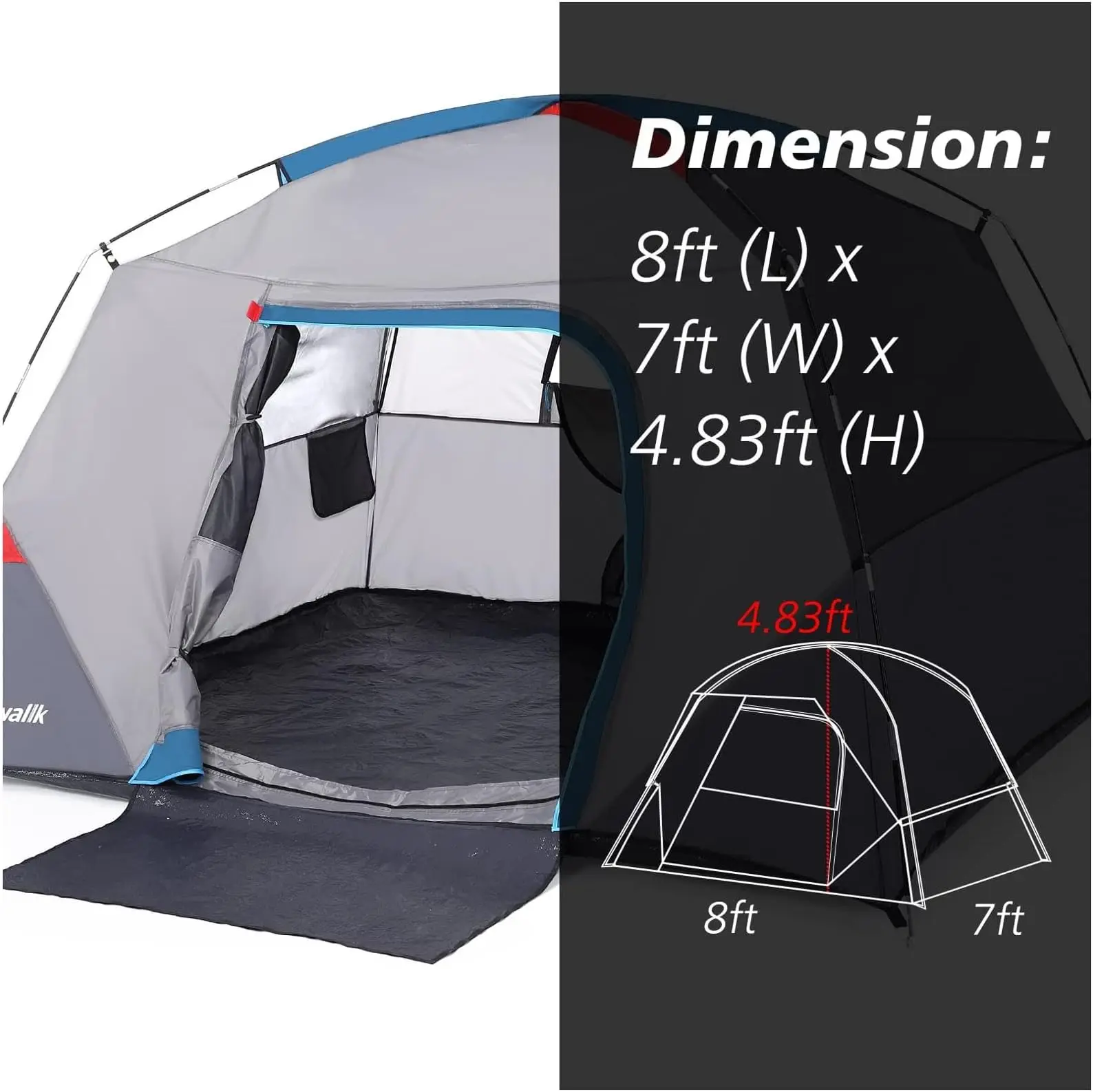
Pros:
– Spacious interior accommodates air mattresses and gear
– Room divider creates privacy options
– Quick setup despite large size
– Well-designed ventilation reduces condensation
Cons:
– Substantial packed size and weight
– Requires larger campsite space
– Higher price point than smaller options
Our pop-up dome tent collection includes several family-friendly options with similar rapid setup benefits.
Best for Extreme Weather
Key Features:
– Reinforced instant-pitch design
– 3000mm+ waterproof rating with fully taped seams
– Additional guyout points for stability
– Four-season capability with snow skirts
– Reinforced pole system withstands higher winds
– Full-coverage rainfly with extended vestibule
Pros:
– Superior weather protection compared to typical quick assembly tents
– Robust construction for extended adventures
– Performs well in wind and heavy precipitation
– Suitable for year-round use in most conditions
Cons:
– Higher price reflects premium materials
– Slightly longer setup time (3-4 minutes) than basic quick assembly options
– Heavier construction for durability
Most Portable Quick Assembly Option
Key Features:
– Ultra-compact folding design
– 2-person capacity in minimalist dimensions
– Simple pop-up mechanism deploys in seconds
– Basic weather resistance for fair conditions
– Under 5 pounds total weight
– Includes compression stuff sack
Pros:
– Lightest quick assembly option available
– More packable than typical instant tents
– Perfect for festivals or overnight adventures
– Easy to transport in smaller vehicles
Cons:
– Limited interior space
– Basic feature set
– Less durable than larger options
– Minimal weather protection
For couples and close friends, our 2-person pop-up tents offer the perfect balance of quick setup and portability.
Easy Setup Camping Tent, Instant Camping Tent
Instant Cabin Tent Double Layer Canvas 1-Minute Setup Spacious Family Camping Shelter with Air Vents$308.10 Select options This product has multiple variants. The options may be chosen on the product pagePop Up Dome Tent, Waterproof Pop Up Tent
$218.89 Select options This product has multiple variants. The options may be chosen on the product page- $633.01 Select options This product has multiple variants. The options may be chosen on the product page
Easy Setup Camping Tent, Trekking Pole Backpacking Tent
$142.40 Select options This product has multiple variants. The options may be chosen on the product pageEasy Setup Camping Tent, Waterproof Camping Tent
All-in-One Elevated 1-Person Camping Tent Cot with Integrated Sleeping System for Outdoor Adventures$535.16 Select options This product has multiple variants. The options may be chosen on the product page
Finding the right quick assembly tent means balancing setup convenience with your specific needs for space, weather protection, and durability. The best instant tents for outdoor adventures combine rapid deployment with reliable performance for a stress-free camping experience.
Maintenance and Care for Longevity
Proper maintenance significantly extends the life of your quick assembly tent, ensuring you enjoy its convenience for many seasons to come:
Cleaning Procedures
• Use only mild soap and lukewarm water for cleaning; harsh chemicals can damage waterproof coatings
• Spot clean dirty areas rather than washing the entire tent when possible
• For stubborn stains, gently scrub with a soft brush and diluted soap (1 oz soap per gallon of water)
• Never machine wash or dry clean your tent regardless of how dirty it becomes
• Allow to air dry completely before storage
Proper Drying and Storage
• Always dry your tent completely before packing away to prevent mold and mildew
• Set up the tent in a shaded area or garage if needed to ensure thorough drying
• Store loosely in a cool, dry place rather than compressed in its stuff sack for long-term storage
• Avoid storing in hot locations like car trunks or attics where heat can degrade materials
• Use a large cotton or mesh storage bag for long-term storage between camping seasons
Regular Inspection Routine
• Check seams for signs of separation or peeling seam tape
• Inspect poles or air beams for cracks, splinters, or leaks
• Examine tent floor for abrasions or punctures, especially along seams
• Test zippers for smooth operation and look for missing teeth
• Verify that all guyline attachment points are secure
Refreshing Waterproofing
• Apply new waterproofing treatment when water stops beading on the surface
• Focus on high-wear areas like the rainfly, tent floor, and seams
• Use appropriate products for your tent’s specific materials (silicone for silicone-treated fabrics, polyurethane for PU-coated materials)
• Apply seam sealer to areas where the original sealing has deteriorated
• Allow treatments to fully cure before packing the tent away
Basic Field Repairs
• Carry a repair kit including: seam sealer, adhesive patch kit, duct tape, and spare cord
• For small tears, apply repair tape to both sides of the fabric
• Use tent pole splints or a tent stake as a temporary repair for broken poles
• Cover holes in the floor with repair patches or seam sealer in emergencies
• Temporarily repair broken zippers with safety pins until proper repair is possible
With proper care, a quality quick assembly tent can provide reliable service for many camping seasons, making your investment in convenience well worth the cost.
FAQ: Common Questions About Quick Assembly Tents
How weather-resistant are quick assembly tents?
Weather resistance varies significantly between models. Basic pop-up tents typically handle light rain and mild winds but struggle in severe conditions. Premium instant tents with quality rainflies and proper guylines can manage moderate storms successfully. For extreme weather, traditional tents still generally offer superior protection, though high-end quick assembly options continue to narrow this gap with innovative designs and materials.
What’s the average lifespan of a quick assembly tent?
With proper care, expect 3-5 years from budget quick assembly tents and 5-8+ years from premium models. Lifespan depends significantly on frequency of use, storage conditions, and exposure to UV radiation, which degrades tent fabrics over time. Regular maintenance and proper storage greatly extend tent longevity.
Can one person really set up an instant tent alone?
Yes, most quick assembly tents are specifically designed for solo setup. Pop-up tents require virtually no effort, while instant tents with hub designs may require walking around the tent to extend multiple legs, but remain manageable for one person. Even large family-sized instant tents can typically be set up by a single person, though having a helper makes the process even faster.
Are quick assembly tents suitable for backpacking?
Most quick assembly tents are not ideal for backpacking due to their weight and bulk. Traditional backpacking tents remain significantly lighter and more packable. However, some ultralight pop-up options under 5 pounds might work for short backpacking trips where setup convenience outweighs weight concerns. The best quick-pitch tents for travelers typically strike a balance between portability and convenience.
How do I repair damaged components in integrated pole systems?
Repairs depend on the specific damage and tent design. Some manufacturers offer replacement pole segments or hub components. For temporary field repairs, duct tape and splints can stabilize broken poles. For permanent fixes, contact the manufacturer for replacement parts or professional repair options, as integrated systems often require specialized components.
Can quick assembly tents be used in winter conditions?
Most quick assembly tents are three-season designs not intended for snow loading or extreme cold. However, some premium models feature stronger poles and winter-ready designs suitable for light snow and cold weather. For serious winter camping, specialized four-season traditional tents remain the safer choice due to their stronger construction and snow-shedding designs.
When Traditional Tents Might Be the Better Choice
While quick assembly tents offer impressive convenience, certain situations still call for traditional tent designs:
Backpacking and Ultralight Adventures
When every ounce matters, traditional backpacking tents maintain a significant advantage. A quality two-person backpacking tent typically weighs 3-4 pounds, while even the lightest quick assembly options generally weigh 5+ pounds. For multi-day hiking trips, this weight difference becomes increasingly significant with each mile traveled.
Extreme Weather Expeditions
For camping in severe conditions—heavy snow, high winds, or sustained storms—traditional expedition tents still offer superior protection. Their specialized designs, reinforced pole structures, and time-tested geometries provide better stability and safety when weather becomes truly challenging.
Budget-Constrained Situations
If cost is your primary concern, traditional tent designs often provide better quality-to-price ratios. A $100 traditional tent typically offers better materials and durability than a $100 quick assembly option, as you’re not paying for the convenience engineering.
Extended Wilderness Trips
For lengthy backcountry expeditions, traditional tents offer advantages in repairability and proven reliability. When far from civilization, the simpler components of traditional tents can be more easily field-repaired with basic tools.
Specialized Feature Requirements
If you need specific features like ultralight materials, extreme packability, or specialized designs for mountaineering, traditional tents offer more options tailored to these specific requirements rather than prioritizing setup speed.
Understanding these scenarios helps you make an informed decision about when the convenience of quick assembly might be outweighed by other important considerations.
Making Your Final Decision: Finding the Perfect Balance
Selecting the ideal quick assembly tent ultimately comes down to understanding your personal camping style and prioritizing what matters most to you:
Consider how frequently you camp and in what conditions. Weekend car campers in mild weather will benefit tremendously from quick assembly options, while those facing extreme conditions might prioritize weather resistance over setup speed.
Match your tent choice to your typical group size, ensuring adequate space for comfortable sleeping and gear storage. Remember that manufacturer capacity ratings typically assume tight quarters—sizing up one or two persons often provides a more comfortable experience.
Evaluate how the convenience of quick setup balances against other factors in your specific situation. If you typically arrive at campsites after a long drive with tired children, the time savings might be invaluable. If you’re an experienced camper who enjoys the process of methodically setting up camp, traditional options might serve you better.
Finally, consider your storage space and transportation limitations. Quick assembly tents generally require more storage room when not in use due to their bulkier packed dimensions.
By thoughtfully weighing these factors against your personal preferences and typical camping scenarios, you’ll find the perfect balance between convenience and performance—making your outdoor adventures more enjoyable with less time spent struggling with tent poles and more time experiencing nature.

